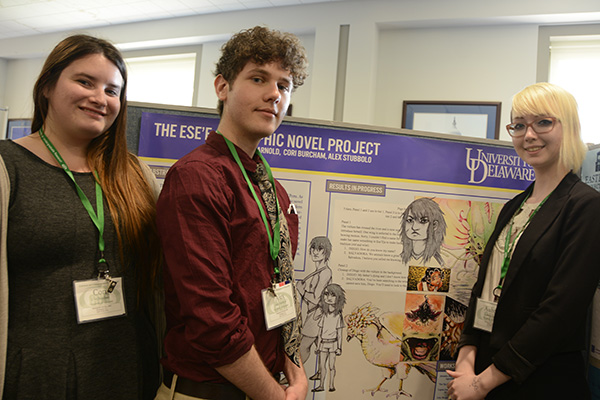
Posters on the Hill
Students' research to create graphic novel showcased at congressional event
2:51 p.m., April 21, 2016--Three University of Delaware undergraduates who are developing a graphic novel to explore the culture of an indigenous group in Peru were selected to present their work to members of Congress and their staffs in Washington, D.C.
English majors Aubrey Arnold and Cori Burcham and biological sciences major Alex Stubbolo worked with Siobhan Carroll, associate professor of English, to develop the “Ese’Eja Graphic Novel Project.” Both Arnold and Burcham are in the Honors Program at UD.
Campus Stories
From graduates, faculty
Doctoral hooding
The students presented a poster describing their work at the April 20 Posters on the Hill event on Capitol Hill, organized each spring by the Council on Undergraduate Research. The UD project was one of 60 — only four of them from the humanities — invited to participate from among hundreds of applicants around the country.
Posters on the Hill aims to raise awareness of the high-quality research undergraduates perform, the impact of this research on students’ professional preparation and the importance of continued investment in undergraduate research support. The event also is designed to help members of Congress understand the importance of undergraduate research by talking directly with student researchers.
The graphic novel originated with an earlier “cultural mapping” project in which an interdisciplinary team of UD students and faculty members conducted research in the Amazonian region of Peru with the Ese’Eja, an indigenous hunting, gathering and fishing people.
Jon Cox, assistant professor of art and design, helped lead that project. He and Rosalie Rolon-Dow, associate professor of education and the Cultural Mapping Project's education director, later approached Carroll with the idea for a book exploring the culture of the Ese’Eja.
“We decided on an anthology, with each of us writing separate but related narratives,” said Arnold, who is writing two stories and contributing her own artwork to the book. “Each story tackles a different issue that’s important to the Ese’Eja.”
The three students, who were not part of the original expedition to Peru, conducted extensive research on the Ese’Eja and on the process of developing visual narratives.
“We wanted to tell an adventure story in an accessible way,” Stubbolo said. “Graphic novels are a really good medium for this project, because we want to communicate with different age groups and with people who have a strong oral tradition.”
Plans call for selling the novel in the United States and, later, to have it translated into Spanish for distribution in Peru. For all audiences — from Ese’Eja children to American adults — the students’ goal is to tell the story of the group accurately and authentically, to promote respect for the Ese’Eja’s culture and way of life, and to raise awareness about the environmental and other challenges they are facing today.
Storylines in the book include a variety of Ese’Eja traditional beliefs and oral legends and history, as well as ways in which the people are seeking to find a balance between their traditions and the modern world.
For Burcham, it was the idea of helping to preserve oral legends that first made the project attractive.
“This reminded me of previous documentations of mythology in literature such as Virgil’s Aeneid or Homer’s Iliad,” she said. “A lot of what we know today about Greek and Roman mythology was preserved in these two works.”
For Stubbolo, combining folklore with serious issues in the novel was a way to reach both the Ese’Eja and those outside their community with important messages.
Burcham agreed: “I hope Ese’Eja children will be able to read these comics and be proud of their cultural identity, and maybe be inspired to create art of their own [with] their own unique worldview,” she said.
Article by Ann Manser
Photo by Iain Crawford








